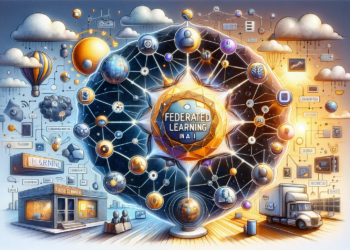Euclidean distance, conceived from classical geometry, represents the length of the shortest segment or “straight line” between two points in a Euclidean space. In the realm of artificial intelligence (AI) and machine learning (ML), this concept has taken on a new dimension, becoming a fundamental tool for measuring similarities or differences between multidimensional entities.
## Theoretical Foundations and Algorithms in AI
The simplest application of Euclidean distance is in the k-nearest neighbors (k-NN) algorithm, where it defines the closeness between data points. However, its relevance spreads to other paradigms, such as in optimizing cost functions in neural networks and clustering with algorithms like k-means, which are essential for market segmentation or genetic analysis.
In detail, the Euclidean distance between two points p and q in an n-dimensional space, with coordinates p=(p1,p2,…,pn) and q=(q1,q2,…,qn), is given by the square root of the sum of the squared differences between the corresponding components of the points:
[
d(p,q) = sqrt{(p1-q1)^2 + (p2-q2)^2 + … + (pn-qn)^2}
]
## Recent Advances and Challenges
While Euclidean distance is intuitive and computationally efficient, it faces challenges in high-dimensional spaces, a phenomenon known as the “curse of dimensionality”. This effect dilutes the notion of proximity, as Euclidean distance tends to become uniform among points. To mitigate this phenomenon, algorithms are emerging that incorporate weights reflecting the importance of each dimension, or dimensionality reduction techniques such as principal component analysis (PCA).
## Emerging Practical Applications
A notable application is found in biometrics, where Euclidean distance helps compare feature vectors in facial recognition systems. In natural language processing (NLP), Euclidean distance is used to assess semantic similarity between word vectors in embedded spaces generated by models like Word2Vec.
## Comparative and Case Studies
Comparatively, in recommendation systems, cosine similarity competes with Euclidean distance, where the former focuses on orientation and the latter on magnitude. An illuminating case study is found on the streaming platform Spotify, which uses a hybrid approach combining both methods to offer personalized recommendations.
## Projections and Future Directions
The projection of Euclidean distance in AI involves adaptations, such as siamese networks that learn to differentiate between classes by mapping data into spaces where Euclidean distance more accurately reflects the relevant semantic similarities. Its evolution also contemplates integration with other metrics in hyperbolic or Riemannian spaces, more suitable for certain complex data representations.
## Final Reflections
In the age of data granularity and advanced computing, Euclidean distance persists as a pillar in the structure of machine learning and AI, adapting and evolving in tune with technological advancements. Its initial simplicity is deceptively deep, and the expansion of its applications and variants continues to offer fertile ground for scientific and technological innovation.






















